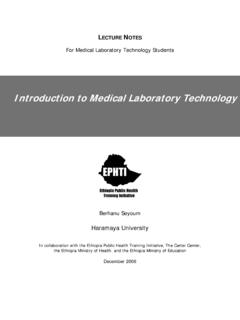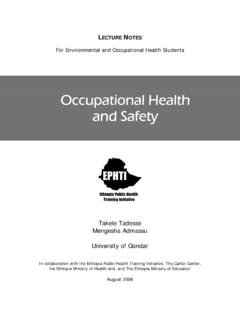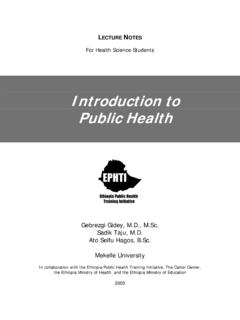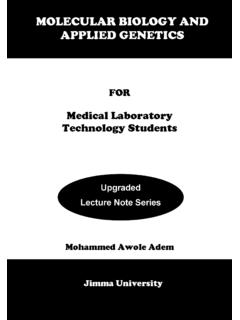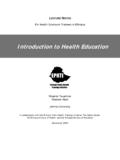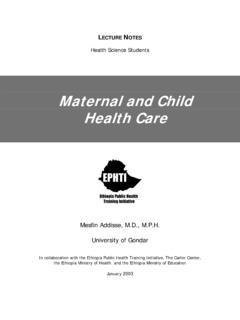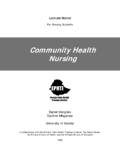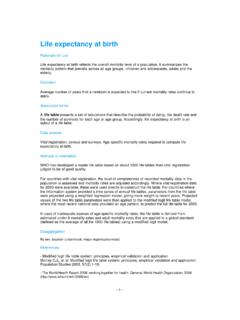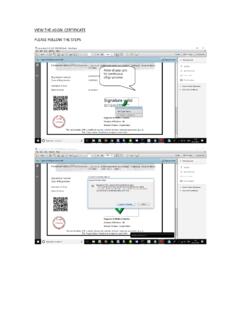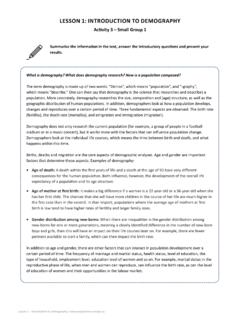Transcription of Population and Development - Carter Center
1 LECTURE NOTES For Health Science Students Population and Development Melake Demena HaramayaUniversity In collaboration with the Ethiopia Public Health Training Initiative, The Carter Center , the Ethiopia Ministry of Health, and the Ethiopia Ministry of Education July 2005 Funded under USAID Cooperative Agreement No. 663-A-00-00-0358-00. Produced in collaboration with the Ethiopia Public Health Training Initiative, The Carter Center , the Ethiopia Ministry of Health, and the Ethiopia Ministry of Education. Important Guidelines for Printing and Photocopying Limited permission is granted free of charge to print or photocopy all pages of this publication for educational, not-for-profit use by health care workers, students or faculty. All copies must retain all author credits and copyright notices included in the original document. Under no circumstances is it permissible to sell or distribute on a commercial basis, or to claim authorship of, copies of material reproduced from this publication.
2 2005 by Melake Demena All rights reserved. Except as expressly provided above, no part of this publication may be reproduced or transmitted in any form or by any means, electronic or mechanical, including photocopying, recording, or by any information storage and retrieval system, without written permission of the author or authors. This material is intended for educational use only by practicing health care workers or students and faculty in a health care field. iPREFACE Studies within particular countries, suggest that Population growth above 2% a year inhibits efforts to raise income in poor countries with high birth rates and young age structure. In countries that are already poor, then, rapid Population growth only makes matters worth leading to economic insecurity. Economic insecurity, intern, encourages people to have large families.
3 Poverty and lack of economic opportunities increase incentives to exploit marginal resources, such as overgrazed land, over harvested forests, and thereby further environmental degradation. Rapid Population growth although not a direct cause, appears to exacerbate all these trends and makes solutions harder to implement. Governments need to provide basic social services (such as health care and education), infrastructure and investments that will lead to job opportunities. The lecture notes on Population and Development Provide information on demographic concepts, current trends of Population growth, patterns and iiinterpretations; and the Impact of rapid Population growth on health and other socio-economic Development .
4 In the absence of relevant text and reference books that are specifically prepared for undergraduate students of health sciences, the lecture notes help to maintain standard of course contents among the different health sciences training institutions and alleviate the scarcity of text books. The lecture notes are primarily prepared for health officer students; however, they could also be used by other categories of medical and health sciences students of diploma or degree level. iiiACKNOWLEDGMENT The Development and publishing this lecture note was made possible through the administrative and financial support of The Carter Center (EPHTI) for which I extend my deepest gratitude. Special acknowledgement goes to Ato Gizachew Ashagire, Gondar University, for his contribution and professional input in developing this document.
5 I would also like to express my heart-felt appreciation to Ato Aklilu Mulugeta for his commitment and moral support for the successful accomplishment of the lecture note. I thank the Alemaya University, the Faculty of Health Sciences and to all colleagues and partners who participated in reviewing the manuscript; and to my students that directly or indirectly contributed to the Development of the lecture note. Last, but not least, I am very grateful to W/t Tinebeb Retta for typing the whole manuscript. ivTABLE OF CONTENT Title Page Preface .. i Acknowledgement .. iii Table of Content .. iv List of Tables .. viii List of Figures .. ix CHAPTER ONE: Introduction to Population Studies .. 1 Demography .. 1 Sources of Demographic Data.
6 2 Census .. 3 registration of Vital Events .. 7 Sample Surveys .. 7 CHAPTER TWO: Demographic Measurement Tools and Techniques .. 9 Tools of Measurement .. 9 Ratios .. 10 Proportions .. 10 Rates .. 11 Techniques of Demographic Measurement .. 12 vMeasures of Fertility .. 12 Measures of Mortality .. 20 CHAPTER THREE: Growth of Populations .. 31 Reasons for Population Growth .. 33 Population Growth Forms .. 35 Population Dynamics .. 37 Population Structure .. 38 Population Pyramids .. 39 The Ecological Ages .. 41 Types of Populations .. 44 Theory of Demographic Transition .. 45 CHAPTER FOUR: World Population Growth, Current Trends, Patterns and Interpretation .. 53 World Population Distribution and Regional Growth Rates .. 55 Trends in Fertility .. 67 Ranges in birth Rates .. 68 Low Fertility in Developed Countries.
7 68 Fertility Decline in Developing World .. 69 Marital Fertility Decline .. 71 Age of Marriage .. 72 Infant Mortality .. 72 viContraception .. 73 Family size Preference .. 74 Education .. 74 Trends in Mortality .. 74 Mechanisms of Mortality Decline .. 77 Mortality Differentials .. 78 Infant Mortality .. 79 Female Education .. 81 Migration .. 81 International Migration .. 82 Internal Migration .. 85 CHAPTER FIVE: Women and Development .. 88 Introduction .. 88 Understanding Gender .. 90 Violence Against Women .. 92 Gender based Violence .. 93 Empowering Women .. 93 Education .. 93 Employment Opportunity .. 94 Legislating Equality .. 95 Emphasizing the Girl Child .. 95 viiMale Responsibility .. 96 Program of Action of the ICPD.
8 97 The status of Women in Ethiopia .. 98 Working conditions .. 98 Social services .. 101 CHAPTER SIX: Impact of Rapid Population Growth on Socio-Economic Development . 107 Social Implications of Population Growth .. 107 Population Growth and Environment .. 108 Health and Development .. 110 Effects of health on Development .. 111 Measures / Indicators of Development .. 115 GNP and Social Indicators and .. 116 Health Indicators and GNP .. 120 CHAPTER SEVEN: Population Policies .. 126 The Population Policy of Ethiopia .. 128 Background .. 128 Rational of the National Population Policy .. 137 Objectives of the National Population Policy .. 138 Reference .. 141 viiiLIST OF TABLES Table : Calculation of Total Fertility Rate.. 17 Table : Population Structure of Town A by Age and Sex, September 2003.
9 51 Table : Distribution of World Population by Regions, 1950, 1990 and 2025.. 61 Table : World Population Number, Vital Rates and GNP in 1992.. 62 Table : Comparison of Gross National Income, and Gross National Income in PPP, (1999).. 63 Table : The 25 Most Populous Countries Ranked by Size, Medium Variant, 1990 and 2025.. 65 Table : Crude death Rate and Life Expectancy in World and Regions.. 77 Table : Life Expectancy at birth by Income Group, 19983.. 121 ixLIST OF FIGURES Fig. : Exponential Growth Curve (J. shaped).. 36 Fig. : Sigmoid Growth Curve (S-Shaped).. 37 Fig. : Age sex Structure in Transition .. 43 Fig. : The Demographic Transition Model.. 48 Fig. : Population Growth through Natural Increase.. 52 Fig. : World Population Growth 7000 6000.
10 59 Fig. : World Population Growth 1750 2150.. 60 Fig. : Links between Health and Income .. 122 1 CHAPTER ONE INTRODUCTION TO Population STUDIES Instructional Objectives 1. Demography Definition Demography can be defined as the study of human populations including their composition, distributions, densities, growth and other characteristics as well as the causes and consequences of changes in these factors. After Completing this chapter the learner is able to: Define Demography Identify the different sources of demographic data Explain the differences between the major sources of data List and state steps needed in conducting Population census. 2 Demography, as understood today, is the scientific study of human Population and its dynamics. It is derived from two Greek Words: Demos means Population Graphics means to draw Demography focuses its attention on three readily available human phenomena: Changes in Population size (growth or decline) The composition of the Population and The distribution of Population in space.
